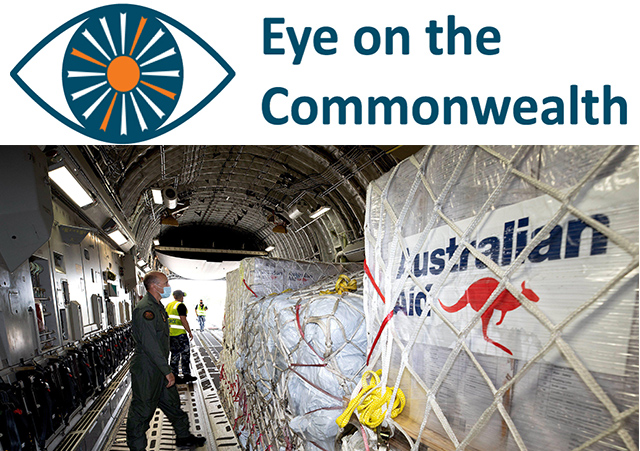 20th January: Operators from No. 23 Squadron load humanitarian assistance supplies bound for Tonga onto a strategic transport aircraft at RAAF Base Amberley. (Credit Image: © Australian Defense Force/ZUMA Press Wire Service/ Alamy)
20th January: Operators from No. 23 Squadron load humanitarian assistance supplies bound for Tonga onto a strategic transport aircraft at RAAF Base Amberley. (Credit Image: © Australian Defense Force/ZUMA Press Wire Service/ Alamy)
Tonga is grappling with the destruction unleashed by a volcanic eruption described by Nasa as being hundreds of times more powerful than the Hiroshima atomic bomb, while also trying to remain free of Covid.
As the South Pacific nation tries to recover from the ashfall and tsunami that followed the world’s biggest volcanic eruption in decades, it faces a dilemma as it looks to rebuild: whether to attempt reconstruction on its own in order to keep Covid-19 at bay, despite lacking trained personnel and key equipment; or to accept foreign aid workers and risk exacerbating the disaster by finally giving the pandemic a bridgehead into the archipelago. The self-enforced isolation of a country where 23% live in poverty has already dealt a heavy blow to an economy reliant on tourism.
The undersea volcano eruption on 15 January was so powerful that the ensuing tsunami swept two women to their deaths from a beach 10,000km away in Peru, and was heard in Alaska, before the outside world knew what was happening in Tonga – because the undersea fibre-optic cable linking it to Fiji had been severed. Three days later, with contact restored, the Tongan government announced that the country had suffered an ‘unprecedented disaster’. The eruption of the Hunga Tonga-Hunga Ha’apai volcano sent waves 15 metres high over the archipelago, killing three people and injuring 15. Lightning was recorded about 400,000 times following the blast. A plume of ash, steam and gas was sent 30km into the sky, with the ash cloud spreading over 260km. The crater, which had been 114 metres above sea level, was destroyed.
Amid the tragedy of homes destroyed and islands abandoned – some of which may be uninhabitable for years – there were also stories of barely believable survival, such as the 57-year-old man swept out to sea from Atata, who stayed afloat for 26 hours until he reached another island. But the long-term effects will be considerable: the ash and tsunami had affected 84% of the population, the prime minister’s office said. Years of development were undone in moments. The Ha’atafu Beach Resort, 21km from the capital, Nuku’alofa, was ‘wiped out’ and the western coastline destroyed, the BBC reported. On remote Mango island, all 62 residents’ homes were obliterated, forcing them to leave for Nomuka Island. Nearly 2cm of grey dust blanketed Tonga, threatening people’s lungs, polluting drinking water in a country with precarious supplies, and ruining crops because of the ashes’ acidity.
Despite the scale of the crisis, Tongans are acutely aware that aid deliveries could exacerbate the crisis in a country that has recorded just one case of Covid, thanks to a quarantine system that requires people coming into the country to isolate for up to three weeks. Curtis Tu’ihalangingie, Tonga’s deputy head of mission in Australia, told Reuters: ‘We don’t want to bring in another wave – a tsunami of Covid-19.’ Contactless methods were used to distribute aid to another Commonwealth member state, Vanuatu, following Cyclone Harold in April 2020, when the government’s Disaster Management Office banned foreign aid workers from entering the country.
For now, aid agencies and foreign governments are planning and supporting their local teams without landing, dropping supplies on to quays, from where they are taken to warehouses for up to 72 hours to prevent infection. When the Australian navy ship HMAS Adelaide found it had more than 20 cases of Covid onboard as it made the 3,300km voyage from Brisbane, it had to deliver its cargo of a desalination plant, helicopters and engineering equipment without making contact with anyone in Tonga. An Australian aid plane was turned around mid-flight after PCR tests showed a positive result, Reuters reported.
Aaron Davy, of New Zealand’s Council for International Development, told the BBC: ‘Emergency provisions are being sent in but personnel are not and strict Covid protocols are followed on delivery. Even when working on the broken communication cable out at sea, the work is being done without personal contact with local people.’ Jonathan Veitch, Unicef’s coordinator for the Pacific Islands, said: ‘Eventually we may need some specialists in Wash [water, sanitation and hygiene] or reconstruction to go in, and then we will need to sort out safe quarantine measures with the government.’
The Tongans’ collective psyche is still scarred by their experience of Spanish flu, which swept through the islands in 1918. It infected most of the population and killed up to 2,000 people, or about one in 12 of the population, in just three months. According to Matangi Tonga Online, the mahaki faka‘auha – the disease that kills – brought silence to even Nuku’alofa, where only the creaking of carts piled with dead bodies could be heard. The disease had arrived on a ship from New Zealand.
Commonwealth Update has become Eye on the Commonwealth: after 38 years in print form, Commonwealth Update has moved from the Round Table journal to the Round Table’s website. Originally Commonwealth Notebook, the column became Commonwealth Update in 1993. The new-look Eye on the Commonwealth will seek to provide a perspective on a topical development by the journal’s Commonwealth Update editor, Oren Gruenbaum.



